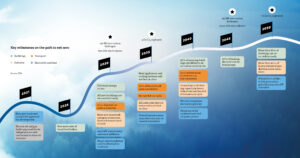In 2021, the International Energy Agency published its first net-zero roadmap, outlining a pathway to limit global warming to no more than 1.5 degrees Celsius. In 2023, an updated version was released, which takes into account the extraordinary growth of certain clean energy technologies, but also highlights increased investments in fossil fuels and persistently high emissions.
Since the release of the first net-zero roadmap in 2021, there have been some positive developments: solar capacity expansion has reached record growth, electric vehicles are gaining more market share, and the industry continues to expand production capacity for these technologies. Innovation in clean energy has also led to more options and a reduction in technology costs. In the IEA’s original 2021 roadmap, technologies that were not yet on the market accounted for nearly half of the emissions reductions needed to achieve net-zero emissions by 2050. In the updated version, this figure has now dropped to about 35 percent.
Nevertheless, significant measures are still required by 2030. According to the updated 2023 roadmap, global renewable energy capacity is expected to triple by 2030. At the same time, the annual rate of improvement in energy efficiency will double, sales of electric vehicles and heat pumps will increase sharply, and methane emissions from the energy sector will decrease by 75 percent. These strategies, which rely on proven and often cost-effective emissions reduction technologies, together will deliver more than 80 percent of the reductions needed by the end of the decade.
“Keeping alive the goal of limiting global warming to 1.5 °C requires the world to come together quickly,” emphasises IEA Executive Director Fatih Birol. “The good news is we know what we need to do – and how to do it.”
IEA’s net-zero roadmap in detail
2021
-
No new unabated coal plants approved for development
-
No new oil and gas fields approved for development; no new coal mines or mine extensions
2025
- No new sales of fossil fuel boilers
2030
-
Universal energy access
-
All new buildings are zero-carbon-ready
-
60 % of global car sales are electric
-
Most new clean technologies in heavy industry demonstrated at scale
-
1,020 GW annual solar and wind additions
-
Phase-out of unabated coal in advanced economies
-
Milestone: 150 Mt low-carbon hydrogen, 850 GW electrolysers
2035
-
Most appliances and cooling systems sold are best in class
-
50 % of heavy truck sales are electric
-
No new ICE car sales
-
All industrial electric motor sales are best in class
-
Overall net-zero emissions electricity in advanced economies
- Milestone: 4 Gt Co2 captured
2040
-
50 % of existing buildings retrofitted to zero-carbon-ready levels
-
50 % of fuels used in aviation are low-emissions
-
Around 90 % of existing capacity in heavy industries reaches end of investment cycle
-
Net-zero emissions electricity globally
-
Phase-out of all unabated coal and oil power plants
2045
-
50 % of heating demand met by heat pumps
- Milestone: 435 Mt low-carbon hydrogen, 3,000 GW electrolysers
2050
-
More than 85 % of buildings are zero-carbon-ready
-
More than 90 % of heavy industrial production is low-emissions
-
Almost 70 % of electricity generation globally from solar PV and wind
- Milestone: 7.6 Gt Co2 captured




